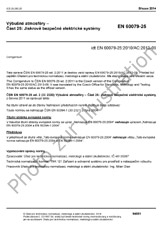Wir benötigen Ihre Einwilligung zur Verwendung der einzelnen Daten, damit Sie unter anderem Informationen zu Ihren Interessen einsehen können. Klicken Sie auf "OK", um Ihre Zustimmung zu erteilen.

CISPR 16-2-1-ed.3.0
Specification for radio disturbance and immunity measuring apparatus and methods - Part 2-1: Methods of measurement of disturbances and immunity - Conducted disturbance measurements
Automatische name übersetzung:
Spezifikation für Funkstörungen und Störfestigkeit Messvorrichtungen und Verfahren - Teil 2-1: Verfahren zur Messung von Störungen und Störfestigkeit - leitungsgeführten Störaussendung
NORM herausgegeben am 26.2.2014
Informationen über die Norm:
Bezeichnung normen: CISPR 16-2-1-ed.3.0
Ausgabedatum normen: 26.2.2014
SKU: NS-116253
Zahl der Seiten: 223
Gewicht ca.: 700 g (1.54 Pfund)
Land: Internationale technische Norm
Kategorie: Technische Normen CISPR
Die Annotation des Normtextes CISPR 16-2-1-ed.3.0 :
CISPR 16-2-1:2014 is designated a basic standard, which specifies the methods of measurement of disturbance phenomena in general in the frequency range 9 kHz to 18 GHz and especially of conducted disturbance phenomena in the frequency range 9 kHz to 30 MHz. With a CDNE, the frequency range is 9 kHz to 300 Hz. This third edition cancels and replaces the second edition published in 2008, Amendment 1:2010 and Amendment 2:2013. This edition constitutes a technical revision which includes added methods of measurement using a new type of ancillary equipment: the CDNE. This consolidated version consists of the third edition (2014) and its amendment 1 (2017). Therefore, no need to order amendment in addition to this publication. The contents of the corrigendum 1 of August 2020 have been included in this copy. Key Words: electromagnetic compatibility, EMC, emissions, immunity La CISPR 16-2-1:2014 est une norme fondamentale qui specifie les methodes de mesure des phenomenes perturbateurs en general, dans la gamme de frequences de 9 kHz a 18 GHz et specialement les perturbations conduites dans la gamme de frequences de 9 kHz a 30 MHz. Avec un CDNE, la gamme de frequences est comprise entre 9 kHz et 300 Hz. Cette troisieme edition annule et remplace la deuxieme edition parue en 2008, lAmendement 1:2010 et lAmendement 2:2013. Cette edition constitue une revision technique qui inclut des methodes de mesure utilisant un nouveau type dequipement dappoint dont lacronyme est: CDNE. Mots cle: compatibilite electromagnetique, CEM, EMC, emissions, immunite Le contenu du corrigendum 1 daout 2020 a ete pris en consideration dans cet exemplaire.
Zugehörige Änderungen zu dieser Norm:
Amendment 1 - Specification for radio disturbance and immunity measuring apparatus and methods - Part 2-1: Methods of measurement of disturbances and immunity - Conducted disturbance measurements
(Amendement 1 - Specifications des methodes et des appareils de mesure des perturbations radioelectriques et de l´immunite aux perturbations radioelectriques - Partie 2-1: Methodes de mesure des perturbations et de l´immunite - Mesures des perturbations conduites)
Änderung herausgegeben am 30.6.2017
Ausgewählte Ausführung:Alle technischen Informationen anzeigen
Zugehörige Korrekturen zu dieser Norm:
Corrigendum 1 - Specification for radio disturbance and immunity measuring apparatus and methods - Part 2-1: Methods of measurement of disturbances and immunity - Conducted disturbance measurements
(Corrigendum 1 - Specifications des methodes et des appareils de mesure des perturbations radioelectriques et de l´immunite aux perturbations radioelectriques - Partie 2-1: Methodes de mesure des perturbations et de l´immunite - Mesures des perturbations conduites)
Korrektur herausgegeben am 31.8.2020
Ausgewählte Ausführung:Alle technischen Informationen anzeigen
Empfehlungen:
Aktualisierung der technischen Normen
Wollen Sie sich sicher sein, dass Sie nur die gültigen technischen Normen verwenden?
Wir bieten Ihnen eine Lösung, die Ihnen eine Monatsübersicht über die Aktualität der von Ihnen angewandten Normen sicher stellt.
Brauchen Sie mehr Informationen? Sehen Sie sich diese Seite an.



 Cookies
Cookies
